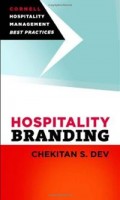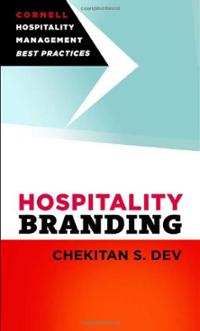 Author: Chekitan S. Dev (also editor of a series of books under Cornell Hospitality Management Best Practices)
Author: Chekitan S. Dev (also editor of a series of books under Cornell Hospitality Management Best Practices)
Publisher: Cornell University Press – 179
Book Review by: Sonu Chandiram
This short book, like others in the series mentioned above, presents research findings on a variety of topics relating to best practices in the hospitality industry. Facilities in the hospitality industry include hotels, motels, banquet halls, resorts, restaurants, and other such places; river and sea cruises; and travel.
In recent decades, branding has become a crucial and critical aspect of marketing and management in the hospitality business. This book presents data and discussions on case studies conducted over a number of years. The research material unearthed is not only important to academicians but also useful to hotel managers and staff.
The role of branding in the hospitality enterprise has taken primacy over other aspects of management, as the author aptly points out:
“Today scholars and industry leaders view branding in a new light. Whereas hospitality business strategy once began with marketing and incorporated branding as one of its elements, such strategy now begins with branding and incorporates marketing within the larger enterprise. The brand has become not only the chief means of attracting customers; it has, more broadly, become the chief organizing principle for most hospitality organizations.”
This book presents the thinking of an individual who has been studying and writing about hospitality marketing and management for some two decades: Chekitan S. Dev. It contains 12 chapters organized around four main sections: Parts I through IV, with a chief case study in each section.
The four sections in this book and the respective case studies discussed in it are:
- The Hospitality Brandscape, with Case Study I on Carnival Cruise Lines
- Global Branding, with Case Study II on Ritz-Carlton Bali
- Strategic Branding, with Case Study III on Taj Hotels, Palaces, and Resorts
- Branding Execution, with Case Study IV on Groupon
The first section provides a broad look at hospitality marketing and branding studies over the last 20 years and a preview of the trends that will highlight the coming years.
The second section offers insights on some effective strategies in today’s globalized world. Some of these strategies have to do with ownership and local management arrangements that help obtain, or maintain competitive advantages in a new market, using the company’s innate strengths and local resources together. For example, the interests of the global corporate ownership-management and the local franchise holders and share owners need to be aligned, to reach commonly-shared goals and targets.
The third section goes deeper into how to use branding as a strategy. For example in chapter 7 of this section, readers are introduced to managing brand equity using a system that measures such equity in quantitative terms.
The fourth section looks at how to carry their brand names directly to the customer. In this section on brand execution, you learn how to attract customers to your properties and after that, how to develop relationships that not only bring them back time and again, but also make them your advocates so that additional corporate and individual customers – come to your hospitality facilities. Here, incentives can be used effectively.
This is a compact but very useful book that contains practical means of building and maintaining a brand name in the hospitality industry. The methods discussed in it on increasing revenues through brand marketing are based on solid research, not just on trial-and-error that could make a facility manager lose time, money and effort. That is one of the chief values of this book, in my opinion.
I would say that this is a must-read book for anyone in hospitality management. Although it is a book only around 180 pages, it provides a wealth of information and empirical data culled from questions in actual surveys. Plus, a list of reference works for further study is provided at the end of each of the 12 chapters of this book, as well as a lengthy bibliography of 11 pages at the end of this book.
So the number of books and other materials named in this book is generous. It enables the reader, including those studying or working in hospitality management, to get more information and insight on a large variety of topics.







